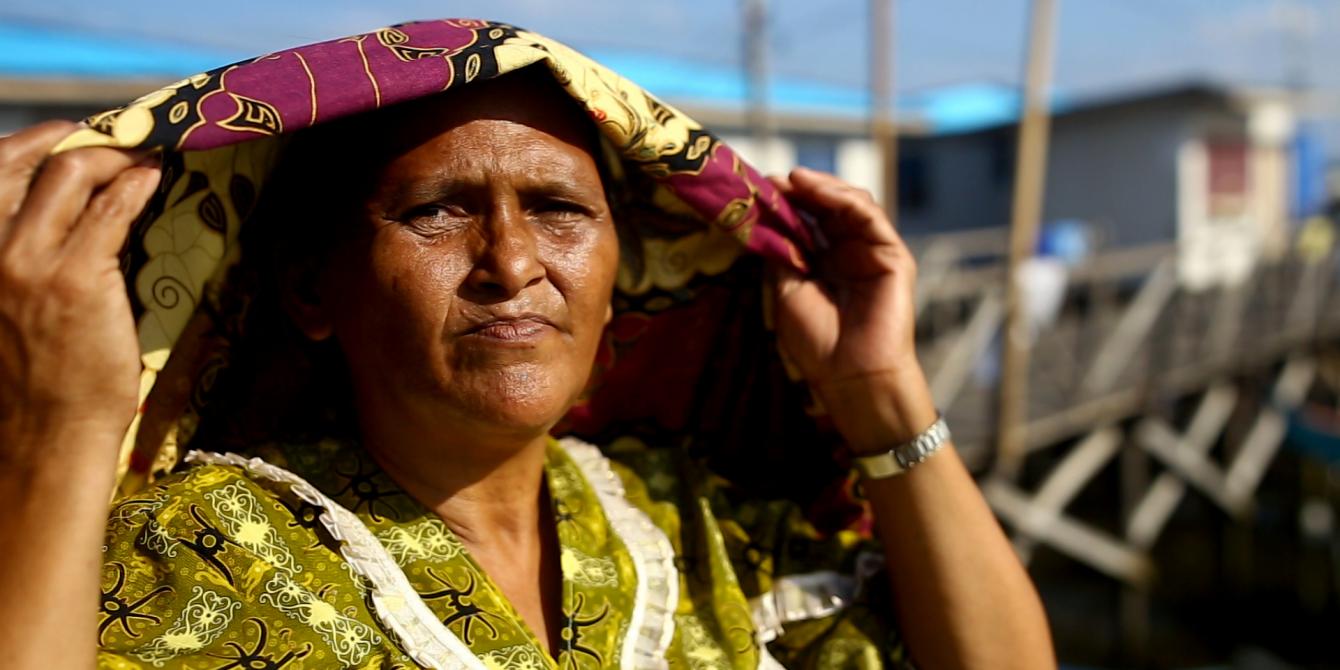Seeking Cover from Rain and Bullets: Gender in Emergencies

The forgotten war. In September 2013, thousands of families were displaced by the Zamboanga siege, forcing them to live in temporary evacuation sites. More than four years after, some families still have not returned home. (Photo: Ferdz Cabrera/COM)
Advancing women’s rights has seen many gains in the Philippines; yet many women continue to experience multiple and intersecting forms of discrimination and oppression. These are magnified during humanitarian emergencies.
As Typhoon Vinta, globally known as Typhoon Tembin, hit Sitio Misalaan in North Cotabato in December 2017, with it came bullets and 105mm howitzer mortar shells. The military offensive was part of an effort to flush out terrorists believed to be hiding in the area. The intensity of the typhoon forced hundreds of families, already displaced from the conflict, to evacuate and seek safer ground. “We have been evacuees all our lives,” remarked a woman forced to flee her home.
Marawi’s “double disaster”
In Mindanao, where Oxfam and its partners have long-term programs, crucial lessons arise from working with affected communities in both Lanao del Norte and del Sur. These provinces were severely impacted by the prolonged fighting in Marawi City from May to October 2017, which was further compounded by Typhoon Vinta later that year, affecting an already displaced and traumatized population. The Department of Health estimates that over 18,000 women in evacuation centers were pregnant or new mothers during the Marawi Siege, many of whom had to be relocated to temporary shelters post-Vinta.
This experience highlights how women and girls are disproportionately affected in emergencies, when responses are defined by prevalent gender norms and practices that perpetuate a narrative of male dominance and a tolerance for gender-based discrimination. Women and girls form the majority of the displaced population. They endure severe and sustained mental, physical, economic, and sexual health consequences. The lack of consistent sex- and age-disaggregated data makes it difficult to measure the magnitude of the problem and prevents effective design, monitoring, and evaluation of responses.
One toilet shared by 35 families
Privacy in evacuation centers or within houses of host-families remains a key concern. Bathing facilities in evacuation centers are not segregated, which leads to increased incidents of gender-based violence. The limited number of toilets – one is shared by 35 families – increases women and girls’ vulnerability in the absence of the security and safety that family and community provide.
Culturally inappropriate, gender discriminatory responses
Affected areas are left without access to safe water-sources because of the combined effects of the conflict and the storm, which damaged or washed away water kits distributed to internally displaced persons (IDPs). This substantially increases susceptibility to diseases, and has serious implications for hygiene and menstrual health. While men and women both face risks, women, as the primary care givers, have the added burden of caring for the sick, including finding cash for medicine and hospital fees.
With livelihoods disrupted, the women IDPs of Marawi have less access to food, and often resort to selling the contents of the food packs they receive to meet other basic needs. In some cases, women have to seek alternative food sources, sometimes requiring them to travel to nearby towns and urban centers. Oxfam and its partners — Humanitarian Response Consortium, Al-Mujadilah Development Foundation, United Youth for the Philippines-Women, and IDEALS, among many others — continue to work with the government in delivering assistance. However, the extensive damage to roads and bridges, and the declaration of martial law in Mindanao, made the delivery of aid more difficult in its earlier phases.
Specialized support for pregnant and breastfeeding women, as well as women and girls of reproductive age, is not prioritized during emergencies. In Marawi, this resulted in unwanted pregnancies, birth complications, and increased risks of maternal and child deaths.
Gender in humanitarian programming
The Marawi experience requires a collective reflection within the humanitarian community, and a rethinking of traditional and masculinist notions of security as paradigms for emergency responses. These traditional and masculinist notions animate, for example, programs that reinforce gender stereotypes, or processes that exclude women and girls from participating meaningfully in decision-making and peace-building processes.
The Marawi experience likewise represents a wake-up call for urgent reforms towards a contextualized humanitarian response and recovery, rather than relying on a one-size fits all framework from which arises inefficient, gender insensitive, and culturally- and age-inappropriate programs. Such an approach worsens the situation of affected populations, especially since the most vulnerable are also the least able to represent themselves.
Lessons learned from the field tell us that humanitarian programming should be viewed with a gender lens. This means including the full participation of women and girls to ensure that their needs and vulnerabilities are made visible, understood, and adequately responded to. Amplifying the voices of women, especially those on the move for a safer and secure future, means shifting from rhetoric to action, and ensuring their human rights are respected and protected during times of emergency and beyond. /ends/


 Follow us on Facebook
Follow us on Facebook Instagram
Instagram Follow us on Twitter
Follow us on Twitter LinkedIn
LinkedIn